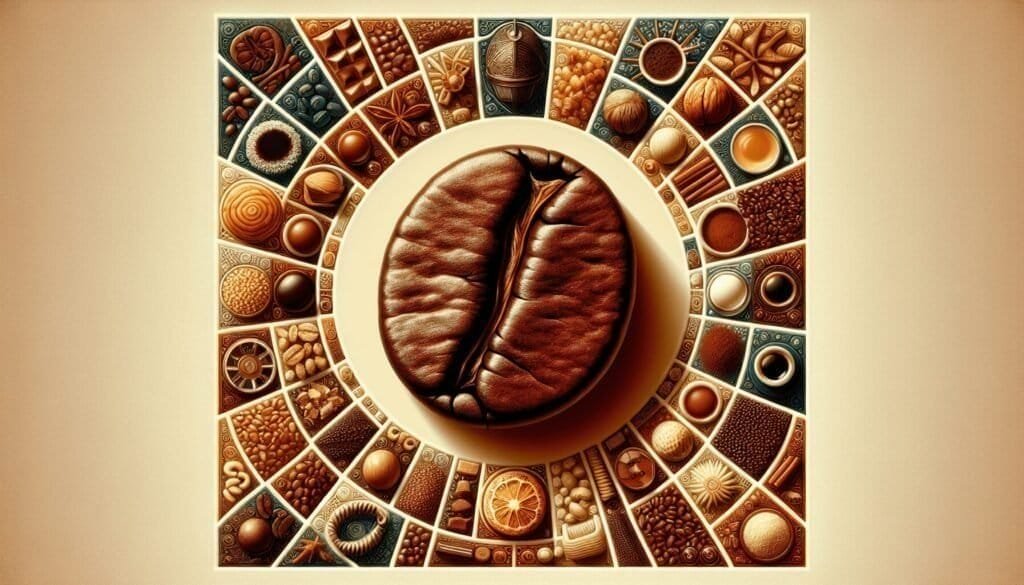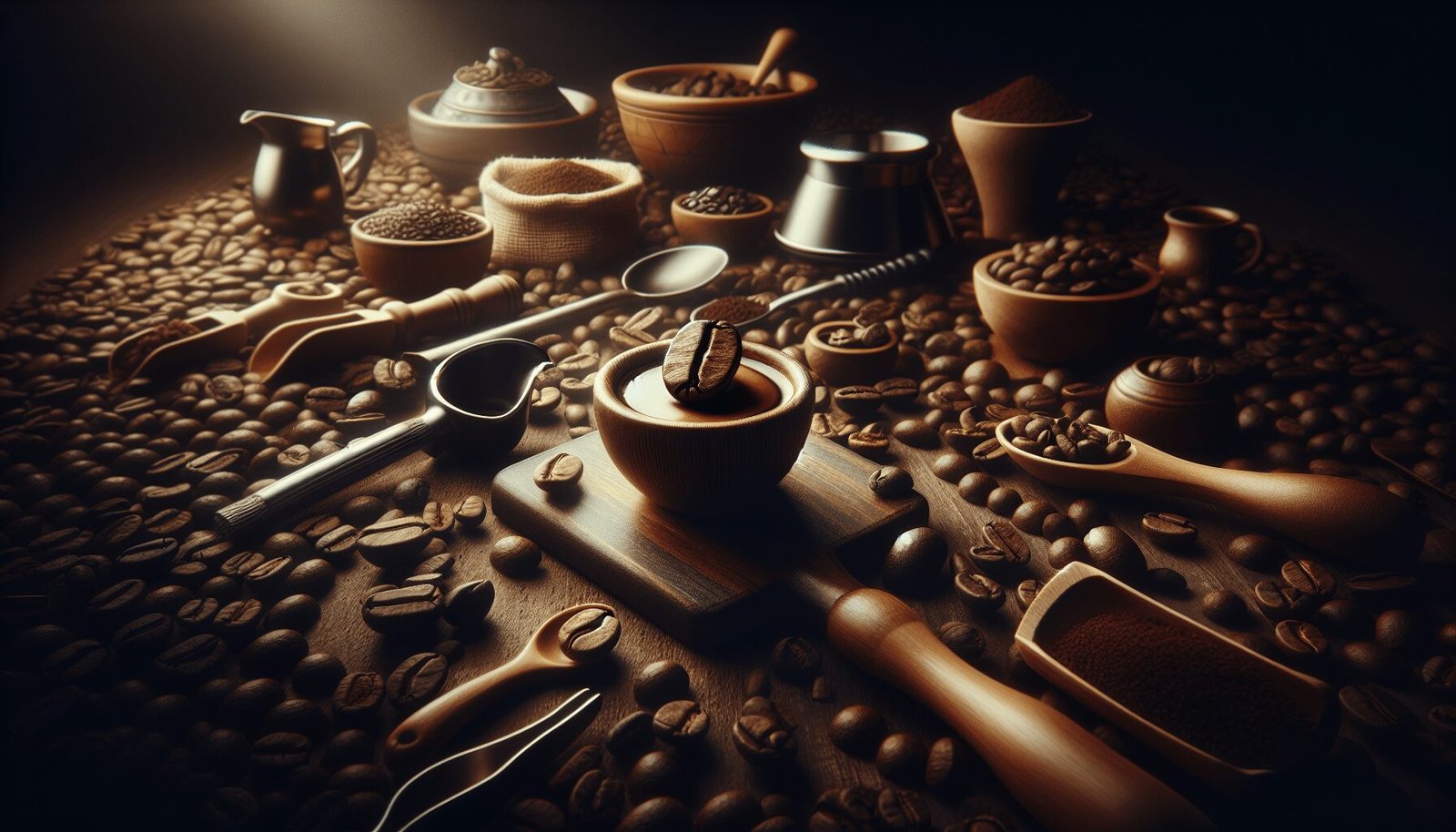Immerse yourself in the world of advanced espresso as you delve into the art of coffee pairings and variatals. Unlock a new level of creativity as you explore the countless flavor combinations and intricate nuances that can be achieved through the marriage of espresso and different types of coffee beans. From bold and rich single origin espressos to delicate and complex blends, embark on a sensory journey that will tantalize your taste buds and ignite your imagination. Whether you’re a seasoned coffee connoisseur or a curious beginner, this article will guide you in unlocking the true potential of your espresso experience. Get ready to journey into the captivating realm of advanced espresso, where the possibilities are as endless as the flavors that await.

Understanding Espresso
Espresso is a concentrated form of coffee that is brewed using high pressure and finely ground coffee beans. It is characterized by its intense flavor and rich, velvety texture. Unlike regular brewed coffee, espresso is made by forcing hot water through compacted coffee grounds, resulting in a beverage that is strong and potent.
Definition of Espresso
Espresso refers to both the brewing method and the resulting beverage. It is a versatile and complex base that can be enjoyed on its own or used as a foundation for various coffee drinks such as lattes, cappuccinos, and macchiatos. The key features of espresso include its concentration, the presence of crema, and its full-bodied taste.
The History of Espresso
The history of espresso dates back to the late 19th century in Italy. It was during this time that Angelo Moriondo first patented an early version of an espresso machine. Over the years, espresso has evolved and gained popularity, first in Italy and then around the world. The invention of the modern espresso machine in the early 20th century revolutionized the coffee industry and paved the way for the widespread availability of espresso.
Key Elements of Espresso
There are several key elements that contribute to the unique characteristics of espresso. These include the coffee beans, the grind size, the brewing time, and the pressure at which the water is forced through the coffee grounds. The quality of these elements greatly impacts the flavor and aroma of the final espresso shot. Achieving the perfect balance of these elements is essential to creating a well-crafted espresso.
Making Espresso: Equipment and Process
To make espresso, you will need an espresso machine that is capable of generating high pressure, finely ground coffee beans, and fresh, filtered water. The process begins by grinding the coffee beans to a fine consistency. The coffee grounds are then evenly distributed and compacted into a portafilter. The portafilter is inserted into the espresso machine, and hot water is forced through the coffee grounds at a pressure of around 9 bars. The resulting espresso shot is collected in a cup and can be enjoyed as is or used as a base for other coffee drinks.
Exploring Coffee Varietals
Coffee varietals refer to the different types of coffee beans that exist around the world. Each varietal has its own unique flavor profile, influenced by factors such as the region where it is grown, the altitude, the soil composition, and the processing methods used.
Definition of Coffee Varietals
Coffee varietals are the different types or species of coffee plants that produce coffee beans. Some common examples of coffee varietals include Arabica, Robusta, and Liberica. Each varietal has its own distinct characteristics that contribute to the overall taste, aroma, and quality of the coffee.
Key Factors Affecting Coffee Varietals
Several key factors significantly influence the flavor and characteristics of coffee varietals. These factors include the region where the coffee is grown, the altitude at which it is cultivated, the climate, the soil composition, and the farming and processing methods employed. All of these elements work together to create a unique flavor profile for each coffee varietal.
Common Types of Coffee Varietals
Arabica and Robusta are two of the most well-known coffee varietals. Arabica coffee is generally considered to be of higher quality and is known for its complex flavor profile, which can include notes of fruit, chocolate, and caramel. Robusta coffee, on the other hand, is known for its higher caffeine content and stronger, more bitter taste.
Difference Between Single-Origin and Blend Varietals
When it comes to coffee varietals, there are two main types: single-origin and blend. Single-origin coffee refers to coffee that is sourced from a single geographical location, such as a specific farm or region. These coffees often showcase the unique characteristics of their origin, allowing coffee enthusiasts to experience the distinct flavors of a specific terroir. Conversely, blend varietals are a combination of different coffee beans from various origins. Blends are often created to achieve a desired flavor profile and can offer a more balanced and consistent taste.
Espresso Extraction Techniques
The process of extracting espresso plays a crucial role in determining the flavor and quality of the final shot. Various extraction techniques can be employed to achieve different results, highlighting different aspects of the coffee’s flavor profile.
Basics of Espresso Extraction
espresso extraction involves the process of dissolving and extracting the soluble compounds from the coffee grounds using hot water under pressure. The goal is to extract the desirable flavors while minimizing the extraction of bitter and undesirable compounds.
Different Espresso Extraction Techniques
Espresso extraction techniques can vary based on factors such as grind size, brewing time, and water temperature. Some common techniques include ristretto, normale, and lungo. A ristretto shot involves pulling a shorter and more concentrated shot, resulting in a sweeter and more pronounced flavor profile. On the other hand, a lungo shot is extracted for a longer duration, resulting in a larger volume of coffee that may have a more bitter taste.
Effect of Extraction Techniques on Coffee Flavors
The choice of extraction technique can greatly impact the flavor profile of the espresso. Different techniques will highlight certain flavor notes, such as acidity, sweetness, or bitterness. Understanding how each technique affects the final flavor allows for more control and customization of the espresso experience.
Common Extraction Mistakes to Avoid
When extracting espresso, there are several common mistakes that can negatively impact the flavor and quality of the shot. These include using an incorrect grind size, improper tamping, inconsistent water temperature, and incorrect extraction time. Avoiding these mistakes and practicing proper extraction techniques will result in a better-tasting espresso.
Coffee Flavor Profiles
Understanding coffee flavor profiles is essential for distinguishing and appreciating the nuances of different coffees. Each coffee has its own unique flavor profile, influenced by factors such as the region, the roast level, and the brewing method used.
Understanding Coffee Flavor Profiles
Coffee flavor profiles refer to the combination of aromas, tastes, and mouthfeel experienced when consuming a particular coffee. These profiles can range from fruity and floral to nutty and chocolatey, with varying levels of acidity, bitterness, and sweetness.
Determining Factors of Coffee Flavor Profiles
Several factors contribute to the flavor profile of coffee, including the origin of the coffee beans, the soil and climate conditions in which they were grown, the processing methods used, and the roast level. Each of these factors plays a crucial role in shaping the final taste and aroma of the coffee.
Common Coffee Flavor Profiles
Some common coffee flavor profiles include fruity, floral, chocolatey, nutty, and earthy. These flavor profiles can vary depending on the specific varietal, roast level, and brewing method used. Exploring different coffee flavor profiles allows coffee lovers to discover their preferences and expand their palate.
How to Taste and Describe Coffee Flavors
Tasting and describing coffee flavors requires a deliberate and focused approach. It involves evaluating the aroma, taste, acidity, body, and aftertaste of the coffee. By paying attention to these elements, coffee enthusiasts can develop their sensory skills and effectively communicate their coffee tasting experiences.

Coffee and Food Pairings
Pairing coffee with food is an art that can greatly enhance the overall sensory experience. When done correctly, the flavors of both the coffee and the food can complement and elevate each other.
The Art of Coffee and Food Pairing
Coffee and food pairing involves carefully selecting complementary flavors and textures that create a harmonious balance. The goal is to enhance the flavors of both the coffee and the food, creating a memorable and satisfying culinary experience.
General Principles of Coffee Pairing
There are several general principles to keep in mind when pairing coffee with food. These include considering the body and intensity of both the coffee and the food, balancing flavors through contrast or similarity, and taking into account regional and cultural pairings.
Specific Coffee and Food Pairing Suggestions
Coffee and food pairing possibilities are virtually endless. Some popular pairings include pairing a medium-bodied coffee with a buttery croissant for a simple breakfast delight, or pairing a dark, rich espresso with a decadent chocolate dessert for a luxurious after-dinner treat. Experimenting with different combinations allows for endless culinary exploration.
How Pairing Elevates the Coffee Experience
Pairing coffee with food not only enhances the flavors of both, but it also provides an opportunity to discover new taste sensations and expand one’s understanding of various flavor combinations. The art of pairing creates a multisensory experience that engages both the palate and the senses, elevating the coffee experience to new heights.
Choosing the Right Coffee Beans
Choosing the right coffee beans is essential for ensuring a satisfying and enjoyable coffee experience. There are several factors to consider when selecting coffee beans, including flavor preferences, sourcing, and understanding coffee labeling.
Factors to Consider When Choosing Coffee Beans
When choosing coffee beans, it is important to consider personal flavor preferences. Do you enjoy a bright, acidic coffee, or do you prefer something more mellow and chocolatey? Understanding your preferred flavor profile will guide you in selecting the right coffee beans to suit your taste.
Understanding Coffee Beans Labeling
Coffee labeling can provide valuable information about the coffee’s origin, roast level, and flavor profile. Paying attention to labels can help narrow down your options and find coffee beans that align with your preferences. Look for labels that specify the coffee’s country or region of origin, the roast level, and any tasting notes provided.
Choosing Beans Based on Flavor Profile Preferences
When selecting coffee beans, it is helpful to consider the flavor profiles associated with different regions or varietals. For example, beans from Ethiopia are often known for their fruity and floral notes, while beans from Brazil are often associated with nutty and chocolatey flavors. Understanding these general flavor profiles can guide you in choosing beans that align with your preferences.
Sourcing Quality Coffee Beans
Sourcing quality coffee beans is essential for a truly exceptional coffee experience. Look for reputable specialty coffee roasters or trusted coffee suppliers that prioritize quality and sustainability. Direct trade or fair trade options can also provide assurance that the beans were sourced ethically and sustainably.
Brewing Techniques for Espresso
The brewing technique used for espresso greatly affects the taste and quality of the final shot. Mastering the art of brewing espresso requires an understanding of the brewing process, as well as attention to detail and precision.
Overview of Brewing Techniques
Brewing espresso involves finely ground coffee, high pressure, and precise brewing parameters. Different brewing techniques can be employed, such as the classic espresso machine, manual espresso makers, or even automatic espresso machines. Each technique has its own unique characteristics and requires specific steps for optimal results.
Step-by-Step Espresso Brewing Process
The espresso brewing process begins by grinding the coffee beans to a fine consistency. The coffee grounds are then evenly distributed and firmly tamped into the portafilter. The portafilter is then locked into the espresso machine, and hot water under pressure is forced through the grounds. The brewed espresso is collected in a cup and should be enjoyed immediately.
Brewing Ratios and How They Impact Flavor
The brewing ratio refers to the ratio of coffee grounds to water used in the brewing process. This ratio greatly impacts the strength and flavor of the espresso shot. Experimenting with different brewing ratios allows for customization and fine-tuning of the final product.
Brewing Mistakes to Avoid
There are several common brewing mistakes that can negatively impact the quality of the espresso. Some of these include using too coarse or too fine of a grind size, improper temperature control, or uneven extraction. Taking the time to practice and refine brewing techniques will lead to consistently better-tasting espresso shots.
Coffee and Alcohol Pairings
Pairing coffee with alcohol offers a unique and enjoyable sensory experience, combining the rich and complex flavors of both beverages. When done thoughtfully, these pairings can enhance the characteristics of each drink and create a delightful combination.
Basics of Coffee and Alcohol Pairing
Coffee and alcohol pairing involves carefully selecting complementary flavors and textures to create a harmonious balance. Just as with food pairings, the goal is to enhance the flavors and create a harmonious taste experience.
Pairing Espresso Coffee with Wine
Pairing espresso coffee with wine can be an intriguing and pleasurable combination. The robust flavors and aromas of espresso can complement the complexities of wine, especially with rich, full-bodied red wines. The bitterness of the espresso can balance the sweetness of certain dessert wines, creating a harmonious contrast of flavors.
Pairing Espresso Coffee with Whisky
Whisky and espresso can make for a delightful pairing that showcases the depth and complexity of both beverages. The bold flavors of espresso can complement the smoky, woody, and sometimes fruity notes of whisky, creating a harmonious balance of tastes. Whether enjoyed side by side or blended together in a cocktail, the combination of espresso and whisky offers a unique and indulgent experience.
Creativity in Coffee & Alcohol Pairings
Pairing coffee with alcohol provides an opportunity for creativity and experimentation. From martinis and craft cocktails infused with coffee to unique combinations of liqueurs and espresso, the possibilities are endless. By exploring different combinations, both classic and innovative, coffee and alcohol enthusiasts can discover a world of exciting flavor experiences.
The Science of Coffee Aromas
The aroma of coffee is a crucial element that greatly influences the overall coffee tasting experience. The complex and diverse range of coffee aromas can be attributed to a variety of chemical compounds and processes.
Understanding Coffee Aromas
Coffee aromas refer to the various scents and fragrances that are released when coffee is brewed and consumed. These aromas can range from fruity and floral to earthy and nutty. The aroma of coffee is one of the first things that make an impression and contribute to the overall sensory experience.
Chemistry Behind Coffee Aromas
The wide array of coffee aromas arises from a complex interaction of chemical compounds present in the coffee beans. Compounds such as volatile organic compounds and aromatic oils contribute to the distinct aromas that can be detected while brewing and drinking coffee. The roasting process also plays a significant role in the development of aromas.
Common Coffee Aromas
Some common coffee aromas include fruity notes such as berries or citrus, floral notes such as jasmine or lavender, and nutty or chocolatey aromas. The specific aromas present in a particular coffee are influenced by various factors, including the coffee varietal, the roast level, and the brewing method.
Influence of Aroma on Coffee Tasting Experience
Aroma greatly influences our perception of taste. The aromas we detect when smelling coffee can enhance and complement the flavors we experience when tasting it. The olfactory senses work in conjunction with taste buds to create a multisensory experience that adds depth and complexity to the overall coffee tasting experience.
Maintaining Coffee Equipment
Proper maintenance of coffee equipment is essential for ensuring the longevity and optimal performance of espresso machines and brewing tools. Regular cleaning and upkeep not only prolong the lifespan of the equipment but also contribute to the quality and consistency of the coffee.
Importance of Coffee Equipment Maintenance
Maintaining coffee equipment is crucial for several reasons. Regular cleaning prevents the buildup of coffee oils, residue, and mineral deposits, which can affect the taste of the coffee and the performance of the equipment. Additionally, proper maintenance extends the lifespan of the equipment, reducing the need for repairs or replacement.
Cleaning and Maintenance of Espresso Machine
Espresso machines require regular cleaning and maintenance to keep them in top condition. This includes daily cleaning of the portafilter, group head, and steam wand, as well as periodic descaling and backflushing to remove any buildup. Following the manufacturer’s recommendations and using appropriate cleaning products is essential for effective maintenance.
Regular Maintenance Tips for Coffee Tools
In addition to espresso machines, other coffee tools such as grinders, scales, and brewing equipment also require regular maintenance. This may include cleaning and calibration of scales, routine cleaning and calibration of grinders, and checking the accuracy and performance of brewing equipment. Regular upkeep ensures consistency and quality in the coffee brewing process.
Impact of Maintenance on Coffee Quality
The cleanliness and proper functioning of coffee equipment directly impact the quality and taste of the coffee produced. A well-maintained machine ensures that the water is heated to the correct temperature, the coffee is extracted evenly, and the flavors are preserved. Neglecting equipment maintenance can result in subpar coffee quality and a less enjoyable coffee experience.
In conclusion, understanding espresso, coffee varietals, extraction techniques, and flavor profiles are key to appreciating the art of coffee pairings and varietals. The choice of coffee beans, brewing techniques, and maintaining coffee equipment also contribute to a satisfying coffee experience. By delving into the intricacies of coffee, one can unlock a world of flavors, aromas, and sensations that elevate the joy of enjoying a cup of coffee. Embark on this journey of discovery, experimentation, and creativity, and savor the endless possibilities that advanced espresso and coffee pairings have to offer.




